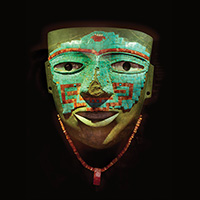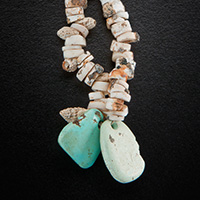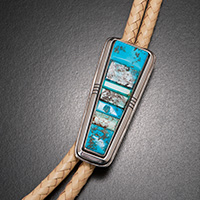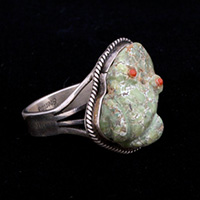The Stone:
Turquoise, the Stone
Turquoise, which symbolizes water throughout the Southwest, is formed by the action of water and only in places where water is scarce. When water seeps through cracks and air pockets in rock, it deposits copper, aluminum, and iron to create turquoise. More copper yields a bluer stone, more iron or aluminum, a greener one.
In the Southwest, turquoise is often paired with shell, coral, and jet. Shell symbolizes water because of its origin. Along with turquoise, shell and jet are often associated with the six cardinal directions by the region’s cultures and thus even more meaningful. Coral is a new addition but has a watery origin and a color like that of argillite, a red stone earlier paired with turquoise.
Turquoise is a soft gemstone. More porous turquoise can absorb environmental oils that darken it and make it greener. Hard, blue deposits of turquoise are highly valued because they do not change color.
Imitation turquoise is an ancient idea but originally was not created with intent to deceive. It was the color, not the material, that was important and conveyed meaning. Today, however, turquoise is purchased by people from many cultures including those that do not value color over composition.
This necklace was worn often, as seen by the darker colored beads at the neck. Turquoise is a relatively soft stone, so that skin oils, cosmetics, and other emollients may change its color. (36093/12, Origin/Artist: Santo Domingo, maker unknown))



